Metro’s federal customers pay fares a little differently than other riders. Why is that such a big deal for Metro’s financial future?
(Third in a series of posts on Metro’s Federal customers – see posts 1 and 2)
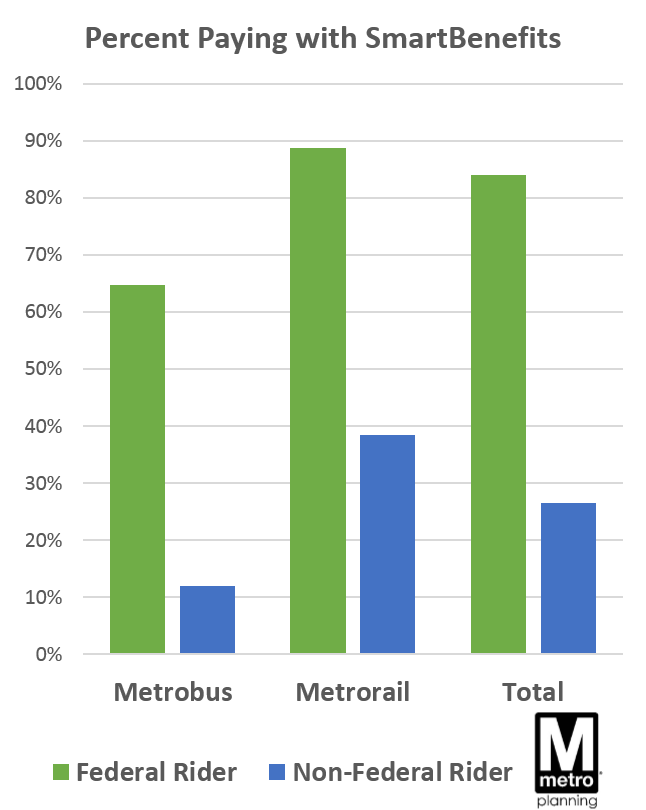 Compared to other riders, Metro’s federal customers are much more likely to pay their fare using SmartBenefits. SmartBenefits are the type of funds you load onto your SmarTrip card – usually through your employer, either as direct subsidy, or a certain amount of pre-tax dollars you set aside for transit fares. Metro riders in the Washington region may know the program manager WageWorks.
Compared to other riders, Metro’s federal customers are much more likely to pay their fare using SmartBenefits. SmartBenefits are the type of funds you load onto your SmarTrip card – usually through your employer, either as direct subsidy, or a certain amount of pre-tax dollars you set aside for transit fares. Metro riders in the Washington region may know the program manager WageWorks.
(Importantly, SmartBenefits is not exclusively a federal government benefit! On the contrary, non-federal workers are nearly half the overall enrollment in the SmartBenefits program, and 42% of Metro’s overall ridership comes from riders paying with SmartBenefits. We’ll make clear the difference between SmartBenefits and SmartTrip in an upcoming Metro 101 post – stay tuned.)
84% of federal employees on Metro pay their fare with SmartBenefits, compared to 27% of non-federal customers. In addition, federal customers tend to pay higher fares on rail – because federal workers typically take longer trips and ride more at peak times (average peak fare $3.00, vs. $2.87 non-federal customers).
Finally, 87% of Metro’s federal customers pay using “stored value” (pay-as-you-go funds), rather than a weekly or a monthly pass. Very few still use paper tickets or passes – but this is similar to other riders.
Read more…
Other than ridership potential, what are some of the other ways we can rank access projects relative to each other?
In our last post, we discussed how bike and pedestrian access projects relate back to ridership and how that relationship could be used to prioritize projects. In this post, we talk about some of the other criteria we are using to prioritize projects.
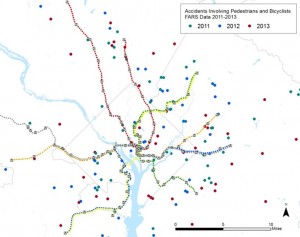
Bike and Pedestrian Fatalities, Sample Data Set
The first is safety. We are pulling together data about bike and pedestrian crashes near our stations that result in injuries or fatalities. We will then link these data in GIS back to the location the project, with the idea being that a new crosswalk or dedicated bike path in an area with a lot of recent crashes should score higher and deserves more attention. A safer path of travel helps not only our customers but all walkers and cyclists in these areas.
We also want to explore some other prioritization criteria. Here is what we have come up with: Read more…
Construction of the K Street Transitway and Union Station to Georgetown Streetcar might result in some growing pains, but Metro & DDOT already have a remedy.
The H/I/K Streets NW Corridor is a heavily congested corridor with traffic frequently backed up and traffic jammed at rush hour. Fortunately, DDOT has approved the K Street Transitway, an exclusive two-way, two-lane median east-west transitway between 20th and 9th Streets NW, to improve the transit and traffic conditions in this corridor. The transitway would also be utilized by a future Union Station to Georgetown streetcar.
Construction of the transitway will likely take a lane or two away from an already congested corridor and Metro would need to reroute our buses to ensure safety and performance.
Current K Street bus service would likely need to detour via H and I Streets NW, but H and I Streets are at capacity!
At rush hour, cars, bikes and pedestrians all fight for limited street space along H and I streets NW. It is common to see bottlenecks, strings of red brake lights, packed crosswalks and cars moving at a sluggish 10.8 MPH through the corridor during the PM Peak. These delays impact our bus service along the corridor. How much service do we have there? A lot. Read more…
State of Good Operations (SOGO) changes coming to a Metrobus route near you.
Metrobus planning presented the annual 2015 Bus State of Good Operations recommendations (PDF) to the Board on November 19. The package was approved and customers will see some changes starting in December. The remainder of the changes will roll out with Metrobus’ March and June schedule changes.
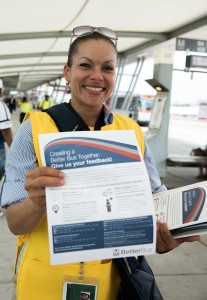
Staff provided SOGO proposal information at outreach events and pop ups, including at the Pentagon Transit Center, photo by WMATA
The annual SOGO process seeks board approval for changes to Metrobus service. Every year, planners put together a comprehensive list of Metrobus routes they want to improve in the coming year. Any major service change must be approved by the board. A major Metrobus service change is defined as
- Change in span of service on a line of more than one hour in a single fiscal year,
- Change in revenue miles on a line of more than 20% in a single fiscal year,
- Change in route miles on a line of 15% in a single fiscal year, or
- Projected change of 10% of the riders on a line in a single fiscal year.
This year, planners were tasked with improving service, reliability, travel time, and crowding while keeping the proposals budget and cost neutral. The recommendations must not have a disparate impact on minority populations or a disproportionate burden on low income populations. Read more…
Think Metro is all about getting the federal commuters to work? Think again!
(First in a series of posts on Metro’s customers who are Federal Government employees)
Just as the workforce in the Washington region has a sizeable share of federal workers, so has Metro’s ridership. Metro serves major federal employment centers downtown, and even boasts stations named for the federal sites they serve, like Federal Triangle, Medical Center, and Pentagon. But while Metro has a long supported the federal government, it’s a myth that Metro is all about federal government commuters and nothing more. Federal workers are a minority of riders and have been for years, and federal funding is playing an increasingly smaller role in Metro’s finances.
So just who are Metro’s federal customers? When and what do they ride? Where are they coming from and going to, and how has this changed in the last decade? The next series of posts seeks to answer just that, using passenger survey data (bus and rail) where customers identified as employees of the federal government or not (contractors excluded).
How Many, Where, and When? About 27% of all Metro weekday trips are made by federal workers – a total of 317,000 boardings across bus and rail. These federal employees can be anyone from a nurse at Walter Reed Medical Center, to a military officer at the Pentagon, to a Congressional staffer on Capitol Hill. The majority of these trips (255,000) are made on Metrorail, where federal workers make up 35% of all boardings (all-day). The remainder – just over 60,000 boardings from federal workers – happen on Metrobus, where riders are generally less likely to be federal workers (14% of all bus boardings are federal).
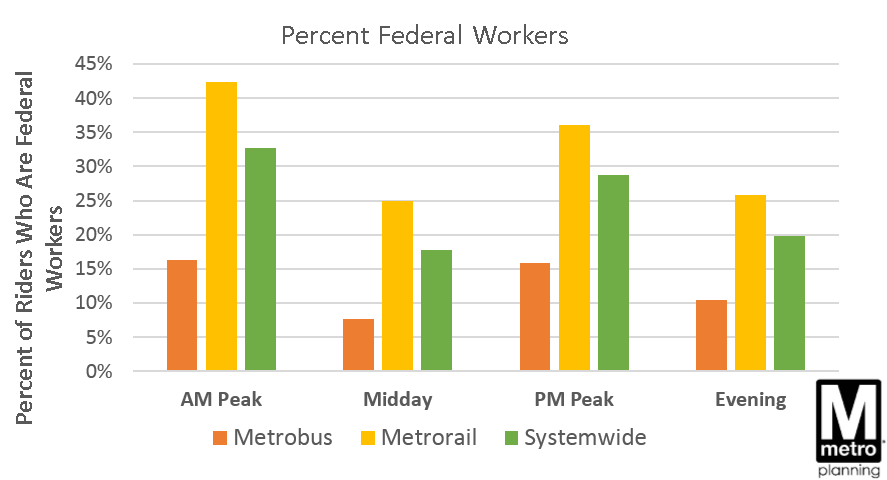 Read more…
Read more…
November 18th, 2015
Wendy
Metrorail ridership isn’t only about rush hour! Here’s a deeper look at why off-peak riders travel, and what segments are most traveled.
You may not be surprised that the peak period travel on Metrorail is dominated by commuting and business related trips. Every day from opening to 9:30am, nearly 90 percent of passengers travel to work and business. However do you know that over almost a third of daily ridership takes place in the off peak? This post explores what is happening during weekday off-peak periods.
The weekday “off-peak” time typically refers to the weekday midday period (9:30am to 3:00pm) and the weekday evening period (from 7:00pm to closing), excluding late night service on Friday and Saturdays between midnight and 3:00am. In recent years, weekday off-peak travel demand has remained stable at 32 percent of the daily ridership, with the midday ridership at 19-20 percent and the evening ridership at 12 percent.
Most non-work trips, such as personal, recreational, and shopping trips, occur during the off-peak times and are spread fairly evenly between the midday and evening, as illustrated in Figure 1.
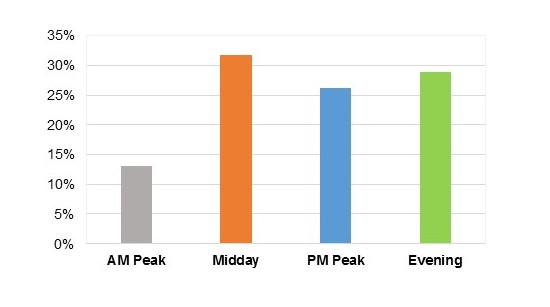
Figure 1: Percentage of Non-Work Trips by Time of Day (2012 Metrorail Passenger Survey)
The off-peak, non-work travel market has showed strong growth between 2007 and 2012 (our last two passenger surveys where we can distinguish between work and non-work travel). According to the Metrorail passenger surveys, off-peak non-work trips grew by 15 percent for the midday and evening from 2007 to 2012, higher than the 9 percent increase in the daily non-work trips. Read more…
November 16th, 2015
Shyam
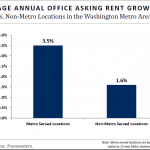
For at least the past decade, the region’s real estate has revolved around transit. That is expected to continue for the next decade, and we can already see signs of its impact along the Silver Line, according to a new report.
We’ve been highlighting the impact that Metro has on the regional economy for many years now. From the Regional Benefits of Transit study which highlighted the quarter of a billion dollars in incremental tax revenue that the jurisdictions enjoy each year solely because of Metro, to recent data which highlights that almost all of the development pipeline in the D.C. region is within walking distance of Metrorail, it’s crystal clear that this region’s economic future is inextricably linked to Metro.
Joining the library of compelling evidence of this is recent information from CoStar and Transwestern. They have been monitoring the development pipeline and activity in the region and have had a special eye trained on the Silver Line. Here’s what they found: Read more…
What if taxpayers could avoid spending hundreds of millions of dollars annually on Metro’s operating subsidy? Better yet – what if Metro could pay for itself and have enough left over to fund local transportation projects? What if better using the transit system we already have could help us achieve this? This isn’t just wishful thinking – it is possible.
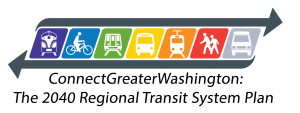 (This is the first post in a series of posts that assess applying land use as a transportation strategy)
(This is the first post in a series of posts that assess applying land use as a transportation strategy)
Recently some of the Washington region’s prominent leaders issued a call to action for this region to cease competing against itself if it is to secure its economic future. Their courageous statement coincided with findings from WMATA’s Office of Planning that actually put a price tag on that promise. And it’s a doozy. In case you missed it, at the Coalition for Smarter Growth‘s Smart Growth Social recently, Shyam Kannan, Metro’s Managing Director of Planning, gave a presentation on the impact of regional cooperation on the region’s finances and specifically, what this could mean for Metro and its ridership, operating subsidy, funding partners, and taxpayers.
What he presented is the second half of ConnectGreaterWashington (CGW). As a reminder, the first part of CGW was a long range plan that identified infrastructure expansion needs across all transit operators in the region. It assumed that we would grow as the local jurisdictions have estimated in the cooperative forecast. This second part asks a different question. It challenges us to make do with the transportation system we have already built. Can the region’s growth, rather than necessitate billions of dollars in new infrastructure, be distributed differently to better utilize the roadway and transit systems we already have? What would that mean to the region, its finances, and to Metro’s operating subsidies that its funding partners pay annually?
So the study contemplates, compares, and contrasts two distinct paths. Grow the way we have been growing and build our way out of congestion. Or choose to grow around our existing infrastructure and use it to its maximum capacity. In the coming weeks, we will be posting the detailed analysis here on PlanItMetro. It’s lengthy and wonky, so be prepared for a series of in-depth posts. Read more…
Categories: Land Use Alternatives Tags: alternatives, benefits, capacity, ConnectGreaterWashington, land use, modeling, planning, plans, scenario, studies, what if
Metrobus is a critical part of the region’s transit system. It can be better, stronger, faster, and more efficient than it is today. Here’s how.
As described in previous posts, Metrobus is due for a regional service update to better reflect its many and sometimes conflicting regional roles. Certainly, updates to its business model, operational scale and performance standards could go a long way towards helping the region make business- and customer-savvy decisions about the best way to deploy this service. However, alone these changes would not significantly enhance cost efficiency, nor make the buses run faster, nor get more people to use the service, nor better connect this region which is hungry for more mobility as it prospers and expands.
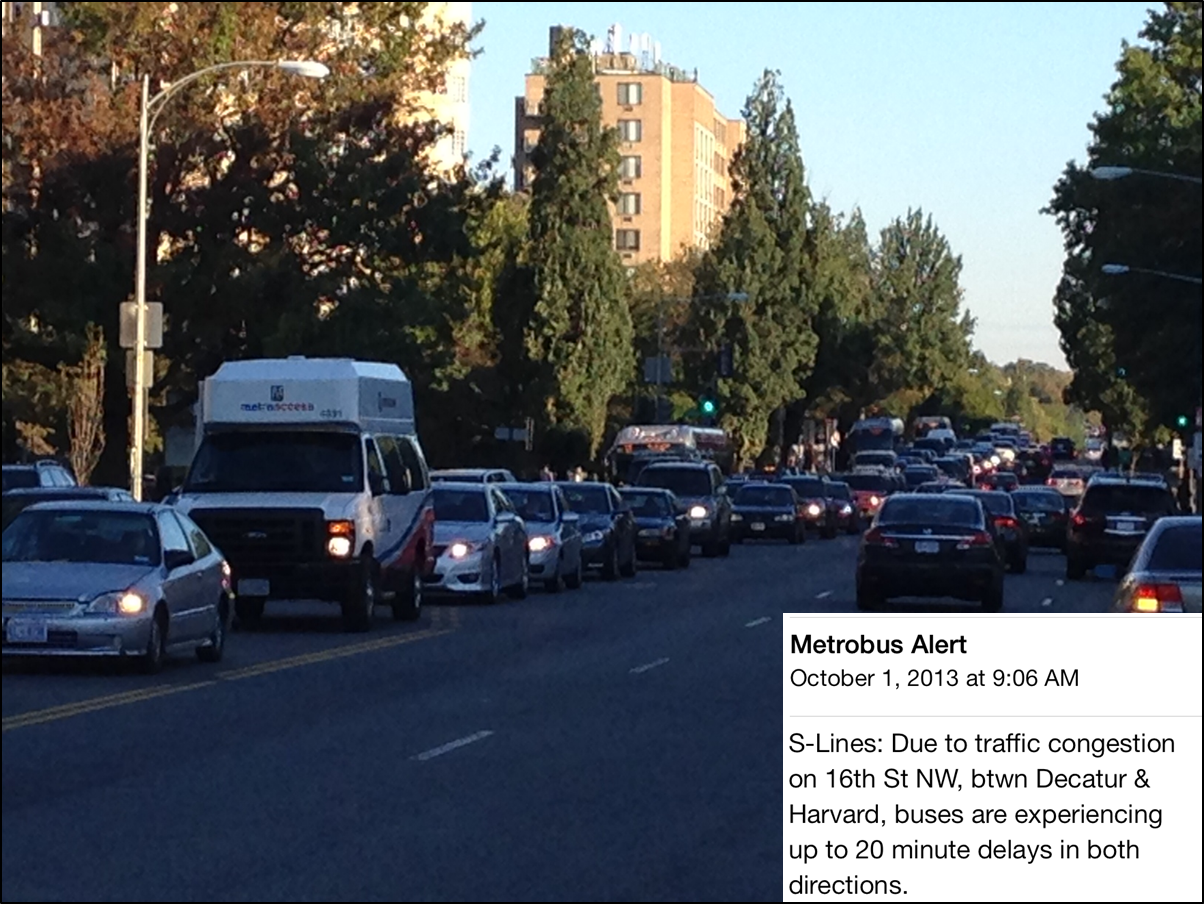
Multiple Metrobus vehicles stuck in traffic on 16th Street in DC, a regular occurance.
Unfortunately, today’s bus operating environment is unsustainable, both operationally and financially. Growing traffic congestion and longer boarding times due to growth in demand have prolonged the scheduled bus travel times, resulting in less reliable service, longer passenger wait times, the use of more fleet just to keep the same headway, and ultimately higher operations costs. As a region we can choose to just accept the service we have, or we can do the heavy lifting to create the service we need (and deserve).
Here is the beginning of a blueprint of near-term actions that can speed up buses, improve on-time performance, and better serve our customers. Read more…
Metro is seeking partnership to deliver up to 13 megawatts of solar electricity at nine different locations.
WMATA has a fair amount of real estate, and some of those assets are ripe for the installation of technology to harness energy from the sun. The Office of Planning began studying where this might in fact be feasible and concluded that there were a number of places where sun patterns and construction feasibility and power draw potentials all coincided to suggest potential solar capacity installation. Installing this capacity can cost money up front, so Metro is pursuing partners who can engage with us in what are called Solar Power Purchase Agreements (PPAs).
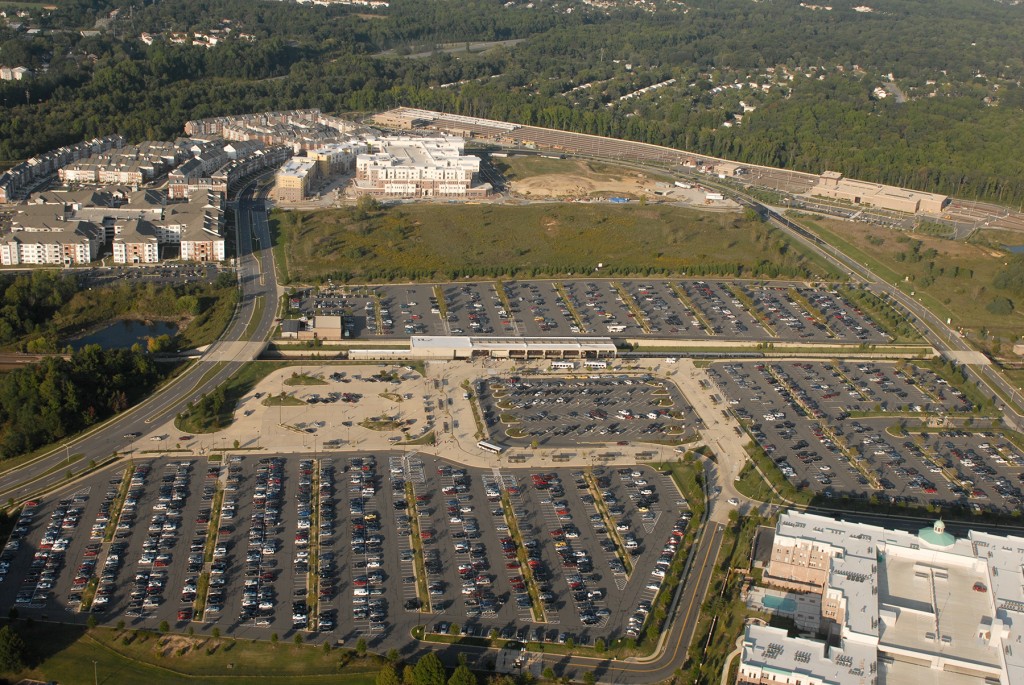
Metro’s parking lots, like this one at the Branch Avenue station, may soon sprout solar carports.
Not only do we expect to reduce operating costs and support renewable energy without using limited capital dollars, installing solar carports in parking lots gives customers improved lighting and shelter from the elements. Maximizing the use of Metro’s assets under a lease or performance-based contract structure such as a PPA supports the focus of the Authority to achieve the resource efficiency and regional sustainability targets set as part of Metro’s Sustainability Initiative.
What do you think of this potential change to Metrorail stations?
On-Site Solar Power Solicitation
 Compared to other riders, Metro’s federal customers are much more likely to pay their fare using SmartBenefits. SmartBenefits are the type of funds you load onto your SmarTrip card – usually through your employer, either as direct subsidy, or a certain amount of pre-tax dollars you set aside for transit fares. Metro riders in the Washington region may know the program manager WageWorks.
Compared to other riders, Metro’s federal customers are much more likely to pay their fare using SmartBenefits. SmartBenefits are the type of funds you load onto your SmarTrip card – usually through your employer, either as direct subsidy, or a certain amount of pre-tax dollars you set aside for transit fares. Metro riders in the Washington region may know the program manager WageWorks.






 (This is the first post in a series of posts that assess applying land use as a transportation strategy)
(This is the first post in a series of posts that assess applying land use as a transportation strategy)


Recent Comments